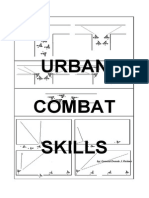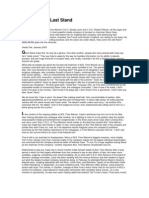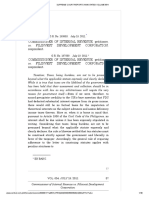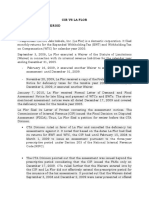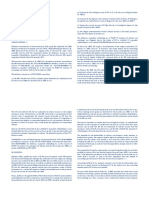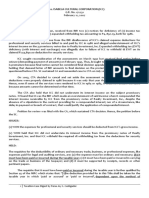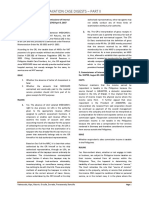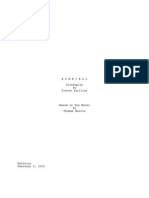0 ratings0% found this document useful (0 votes)
19 viewsCIR v. La Flor Dela Isabela, Inc.
CIR v. La Flor Dela Isabela, Inc.
Uploaded by
Rolando Mauring ReubalCopyright:
© All Rights Reserved
Available Formats
Download as DOCX, PDF, TXT or read online from Scribd
CIR v. La Flor Dela Isabela, Inc.
CIR v. La Flor Dela Isabela, Inc.
Uploaded by
Rolando Mauring Reubal0 ratings0% found this document useful (0 votes)
19 views1 pageOriginal Title
73. CIR v. La Flor Dela Isabela, Inc.
Copyright
© © All Rights Reserved
Available Formats
DOCX, PDF, TXT or read online from Scribd
Share this document
Did you find this document useful?
Is this content inappropriate?
Copyright:
© All Rights Reserved
Available Formats
Download as DOCX, PDF, TXT or read online from Scribd
Download as docx, pdf, or txt
0 ratings0% found this document useful (0 votes)
19 views1 pageCIR v. La Flor Dela Isabela, Inc.
CIR v. La Flor Dela Isabela, Inc.
Uploaded by
Rolando Mauring ReubalCopyright:
© All Rights Reserved
Available Formats
Download as DOCX, PDF, TXT or read online from Scribd
Download as docx, pdf, or txt
You are on page 1of 1
73. Commissioner of Internal Revenue v.
La Flor Dela It is true that withholding tax is a method of collecting tax
Isabela, Inc. in advance and that a withholding tax on income
G.R. No. 211289 14 January 2019 necessarily implies that the amount of tax withheld comes
from the income earned by the
Doctrine: taxpayer/payee. Nonetheless, the Court does not agree
with the CIR that withholding tax assessments are merely
Withholding taxes are internal revenue taxes and an imposition of a penalty on the withholding agent, and
withholding tax assessments are not merely an imposition thus, outside the coverage of Section 203 of the NIRC.
of a penalty on the withholding agent, and thus, both are
covered by section 203 of the NIRC Thus, withholding tax assessments such as EWT and
WTC clearly contemplate deficiency internal revenue
Facts: taxes. Their aim is to collect unpaid income taxes and not
merely to impose a penalty on the withholding agent for
Respondent La Flor dela Isabela, Inc. (La Flor) is a domestic its failure to comply with its statutory duty. Further, a
corporation duly organized and existing under Philippine holistic reading of the Tax Code reveals that the CIR's
Law. It filed monthly returns for the Expanded Withholding interpretation of Section 203 is erroneous. Provisions of
Tax (EWT) and Withholding Tax on Compensation (WTC) the NIRC itself recognize that the tax assessment for
for calendar year 2005. withholding tax deficiency is different and independent
from possible penalties that may be imposed for the
failure of withholding agents to withhold and remit taxes.
On September 3, 2008, La Flor, through its president,
executed a Waiver of the Statute of Limitations in
It is clear to see that the "penalties" are amounts
connection with its internal revenue liabilities for the
collected on top of the deficiency tax assessments
calendar year ending December 31, 2005. On February 16,
including deficiency withholding tax assessments. Thus, it
2009, it executed another Waiver to extend the period of
was wrong for the CIR to restrict the EWT and WTC
assessment until December 31, 2009.
assessments against La Floras only for the purpose of
imposing penalties and not for the collection of internal
On January 7, 2010, La Flor received the Formal Letter of
revenue taxes.
Demand and Final Assessment Notices. On January 15,
2010, La Flor filed its Letter of Protest contesting the
assessment notices. On July 20, 2010, petitioner
2. Waivers extending the prescriptive period of tax
Commissioner of Internal Revenue issued the Final
assessments must be compliant with RMO No. 20-90
Decision on Disputed Assessment (FDDA) involving the
and must indicate the nature and amount of the tax
alleged deficiency withholding taxes in the aggregate
due.
amount of ₱6,835,994.76. Aggrieved, it filed a petition for
review before the CTA Division.
The CIR argued that even if Section 203 of the NIRC was
applicable, the assessments against La Flor had yet to
CTA: ruled in favor of La Flor and cancelled the deficiency
prescribe. It points out that La Flor had executed three
tax assessments against it.
Waivers to extend the statutory prescriptive period. It
adds that the requirements under RMO No. 20-90 are not
CTA En Banc: affirmed the decision of the CTA.
mandatory.
Issue:
In the present case, the September 3, 2008, February 16,
2009 and December 2, 2009 Waivers failed to indicate the
1. Whether or not the prescriptive period under section
specific tax involved and the exact amount of the tax to be
203 of the NIRC applies to EWT and WTC
assessed or collected. As above-mentioned, these details
assessments. – YES
are material as there can be no true and valid agreement
2. Whether or not La Flor's EWT and WTC assessments
between the taxpayer and the CIR absent these
for 2005 were barred by prescription. – YES
information. Clearly, the Waivers did not effectively extend
the prescriptive period under Section 203 on account of
Ratio:
their invalidity. The issue on whether the CTA was correct
in not admitting them as evidence becomes immaterial
1. The Court did not equate withholding tax
since even if they were properly offered or considered by
assessments to the imposition of civil penalties
the CTA, the same conclusion would be reached — the
imposed on tax deficiencies. The word "penalty" was
assessments had prescribed as there was no valid waiver.
used to underscore the dynamics in the withholding
tax system that it is the income of the payee being
By: Rolando M. Reubal
subjected to tax and not of the withholding agent. It
was never meant to mean that withholding taxes do
not fall within the definition of internal revenue taxes,
especially considering that income taxes are the ones
withheld by the withholding agent. Withholding taxes
do not cease to become income taxes just because it
is collected and paid by the withholding agent.
You might also like
- Urban Combat SkillsDocument53 pagesUrban Combat SkillsDelta Exrae95% (38)
- Enter A Better Life: Sub: Sanctlon Letter For Financial FacilityDocument2 pagesEnter A Better Life: Sub: Sanctlon Letter For Financial Facilityinfoski khan100% (2)
- History MagellanDocument3 pagesHistory MagellanElijah Dayuta76% (17)
- Steve CaseDocument8 pagesSteve CasedharmeshNo ratings yet
- XDocument1 pageXSophiaFrancescaEspinosaNo ratings yet
- Module 4 Withholding Tax Case DigestsDocument15 pagesModule 4 Withholding Tax Case DigestsMVSNo ratings yet
- CIR vs. LA FLOR DEla ISABELA, 2019Document3 pagesCIR vs. LA FLOR DEla ISABELA, 2019Fenina Reyes0% (1)
- CIR vs. La FlorDocument13 pagesCIR vs. La FlorKim RoqueNo ratings yet
- CIR vs. La FlorDocument13 pagesCIR vs. La FlorAngel VirayNo ratings yet
- Commissioner of Internal Revenue vs. Vda. de Prieto (1960) : Facts: RatioDocument4 pagesCommissioner of Internal Revenue vs. Vda. de Prieto (1960) : Facts: Ratiojm sanpedroNo ratings yet
- CIR vs. La Flor Isabela 211289Document1 pageCIR vs. La Flor Isabela 211289magen100% (1)
- Coral Bay Nickel Vs CIRDocument5 pagesCoral Bay Nickel Vs CIRCJ CasedaNo ratings yet
- Validity of The Waivers: CTA-First Division Partially Granted The Petition For ReviewDocument2 pagesValidity of The Waivers: CTA-First Division Partially Granted The Petition For ReviewMarcella Maria KaraanNo ratings yet
- Asian Transmission Corp. vs. CIRDocument2 pagesAsian Transmission Corp. vs. CIRRhea Caguete50% (2)
- CIR v. La Flor Case DigestDocument1 pageCIR v. La Flor Case Digestlaurence obaobNo ratings yet
- Doctrine Format 4Document1 pageDoctrine Format 4ava.angelph0enixNo ratings yet
- 10. DIGEST Commissioner of Internal Revenue vs. La Flor Dela Isabela, Inc_Document2 pages10. DIGEST Commissioner of Internal Revenue vs. La Flor Dela Isabela, Inc_Michael James DuazoNo ratings yet
- 1) Cir Vs Pascor (Gallo)Document5 pages1) Cir Vs Pascor (Gallo)kaiaceegeesNo ratings yet
- Tridharma Vs CTADocument1 pageTridharma Vs CTAKaren Mae ServanNo ratings yet
- Toaz - Info Tridharma Vs Cta PRDocument1 pageToaz - Info Tridharma Vs Cta PRHelen Joy F. Javier - AdvientoNo ratings yet
- Tax Alert Regular Issue (March 2020)Document19 pagesTax Alert Regular Issue (March 2020)Rheneir MoraNo ratings yet
- Tax LawDocument32 pagesTax Lawgilbert213No ratings yet
- 48 CIR V IsabelaDocument4 pages48 CIR V IsabelaYodh Jamin OngNo ratings yet
- Chapter 3-Income: Cir vs. Lancaster Philippines IncDocument18 pagesChapter 3-Income: Cir vs. Lancaster Philippines IncannelyseNo ratings yet
- 3 CIR Vs FILINVESTDocument40 pages3 CIR Vs FILINVESTLouise Nicole AlcobaNo ratings yet
- 11 CIR vs. Next MobileDocument20 pages11 CIR vs. Next MobileDianne LingalNo ratings yet
- COMMISSIONER OF INTERNAL REVENUE v. LA FLOR DELA ISABELA, INC.Document1 pageCOMMISSIONER OF INTERNAL REVENUE v. LA FLOR DELA ISABELA, INC.John Kenneth Jacinto0% (1)
- TAX Case Digest Batch 3Document13 pagesTAX Case Digest Batch 3manabatrozetteNo ratings yet
- PWC Client AdvisoryDocument8 pagesPWC Client AdvisoryFedsNo ratings yet
- Metro Inc v. CIRDocument2 pagesMetro Inc v. CIRJahn Avery Mitchel DatukonNo ratings yet
- Cir Vs La Flor Re: Prescriptive Period FactsDocument3 pagesCir Vs La Flor Re: Prescriptive Period FactsGrazielNo ratings yet
- Tax Alert September 2020 Final v2Document6 pagesTax Alert September 2020 Final v2Rheneir MoraNo ratings yet
- PWC News Alert 1 August 2017 No Tax Withholding Required On Reimbursement of ExpensesDocument3 pagesPWC News Alert 1 August 2017 No Tax Withholding Required On Reimbursement of ExpensesNiileshNo ratings yet
- Commissioner of Internal Revenue vs. Filinvest Development CorporationDocument7 pagesCommissioner of Internal Revenue vs. Filinvest Development Corporationcarl dianneNo ratings yet
- Taxation 1 - Atty. Santos Case Digests (Limitations)Document69 pagesTaxation 1 - Atty. Santos Case Digests (Limitations)Jan VelascoNo ratings yet
- Cir VS La Flor PDFDocument3 pagesCir VS La Flor PDFGrazielNo ratings yet
- Income TaxationDocument15 pagesIncome TaxationHabib SimbanNo ratings yet
- Tax CasesDocument28 pagesTax CasesWhoopi Jane MagdozaNo ratings yet
- 2 - CBNC vs. CIRDocument13 pages2 - CBNC vs. CIRJeanne CalalinNo ratings yet
- Dr. Jeannie P. LimDocument38 pagesDr. Jeannie P. LimSHeena MaRie ErAsmoNo ratings yet
- Refining Company v. CA G.R. No. 118794 May 8, 1996Document10 pagesRefining Company v. CA G.R. No. 118794 May 8, 1996Dani McstNo ratings yet
- Filipinas Synthetic Fiber Corp. Vs CA, CTA and CIRDocument3 pagesFilipinas Synthetic Fiber Corp. Vs CA, CTA and CIRNathalie YapNo ratings yet
- Tax Digest Cañero PDFDocument9 pagesTax Digest Cañero PDFGreghvon MatolNo ratings yet
- Cir vs. Isabela Cultural Corporation (Icc) : 1 Taxation Case Digest by Rena Joy C. CastigadorDocument2 pagesCir vs. Isabela Cultural Corporation (Icc) : 1 Taxation Case Digest by Rena Joy C. CastigadorsakuraNo ratings yet
- CIR vs. Bank of Commerce (2005)Document16 pagesCIR vs. Bank of Commerce (2005)BenNo ratings yet
- c.11. Filipinas Synthetic Fiber Corp v. CADocument1 pagec.11. Filipinas Synthetic Fiber Corp v. CAArbie LlesisNo ratings yet
- Taxation Case Digests Part IIDocument35 pagesTaxation Case Digests Part IIAdNU College of Law LibraryNo ratings yet
- Commissioner of Internal Revenue vs. Next Mobile, IncDocument20 pagesCommissioner of Internal Revenue vs. Next Mobile, IncNestor LimNo ratings yet
- G.R. No. 211289Document8 pagesG.R. No. 211289Ran NgiNo ratings yet
- Pa Tax Brief - November 2019Document10 pagesPa Tax Brief - November 2019Teresita TibayanNo ratings yet
- Tax Alert: Notable Issues On Personal Income Tax Finalization in 2023Document4 pagesTax Alert: Notable Issues On Personal Income Tax Finalization in 2023K60 Tăng Minh NgọcNo ratings yet
- Tax 2 Midterms Exam ReviewerDocument66 pagesTax 2 Midterms Exam ReviewerFlorence Rosete100% (1)
- Tax DigestDocument7 pagesTax DigestLeo Angelo LuyonNo ratings yet
- Adamson V CADocument25 pagesAdamson V CAYe Seul DvngrcNo ratings yet
- Tax-Remedies (Govt-Remedies-Highlights)Document38 pagesTax-Remedies (Govt-Remedies-Highlights)Yves Nicollete LabadanNo ratings yet
- Coral Vs CirDocument13 pagesCoral Vs CirJAMNo ratings yet
- REMEDIES by Atty. LimDocument4 pagesREMEDIES by Atty. LimJeninah Arriola CalimlimNo ratings yet
- Full Text 3rd Exam TaxDocument45 pagesFull Text 3rd Exam TaxAna AltisoNo ratings yet
- Tax Review Case Digests PartialDocument24 pagesTax Review Case Digests PartialAnne sherly OdevilasNo ratings yet
- CIR vs. ISABELA CULTURAL CORPDocument2 pagesCIR vs. ISABELA CULTURAL CORPRenmarc JuangcoNo ratings yet
- 45 CIR vs. Liquigaz Philippines CorporationDocument3 pages45 CIR vs. Liquigaz Philippines CorporationOzacNo ratings yet
- 1040 Exam Prep Module III: Items Excluded from Gross IncomeFrom Everand1040 Exam Prep Module III: Items Excluded from Gross IncomeRating: 1 out of 5 stars1/5 (1)
- 1040 Exam Prep - Module I: The Form 1040 FormulaFrom Everand1040 Exam Prep - Module I: The Form 1040 FormulaRating: 1 out of 5 stars1/5 (3)
- Cases For 8:4:21Document30 pagesCases For 8:4:21Rolando Mauring ReubalNo ratings yet
- PALE Cases 1Document200 pagesPALE Cases 1Rolando Mauring ReubalNo ratings yet
- Far East Bank and Trust Company v. CIRDocument1 pageFar East Bank and Trust Company v. CIRRolando Mauring ReubalNo ratings yet
- B. 1st Batch Arts. 1767-1783Document96 pagesB. 1st Batch Arts. 1767-1783Rolando Mauring ReubalNo ratings yet
- Art. 799 Cases 9-17Document43 pagesArt. 799 Cases 9-17Rolando Mauring ReubalNo ratings yet
- Rule 76 Full TextDocument213 pagesRule 76 Full TextRolando Mauring ReubalNo ratings yet
- Rule 76 Case DigestsDocument24 pagesRule 76 Case DigestsRolando Mauring ReubalNo ratings yet
- Tax 2 Cases (1-6) Full TextDocument23 pagesTax 2 Cases (1-6) Full TextRolando Mauring ReubalNo ratings yet
- Midterm Double Jeopardy CasesDocument25 pagesMidterm Double Jeopardy CasesRolando Mauring ReubalNo ratings yet
- Rules 123-126 CasesDocument21 pagesRules 123-126 CasesRolando Mauring ReubalNo ratings yet
- Sps Torrecampo Vs AlindoganDocument5 pagesSps Torrecampo Vs AlindoganRolando Mauring ReubalNo ratings yet
- Vasquez VS Ayala CorpDocument21 pagesVasquez VS Ayala CorpRolando Mauring ReubalNo ratings yet
- Santiago F. Bautista For Plaintiff-Appellee. Jesus G. Villamar For Defendant-AppellantDocument7 pagesSantiago F. Bautista For Plaintiff-Appellee. Jesus G. Villamar For Defendant-AppellantRolando Mauring ReubalNo ratings yet
- Francisco A. Tan For Petitioners. Von Kaiser P. Soro For Private RespondentDocument18 pagesFrancisco A. Tan For Petitioners. Von Kaiser P. Soro For Private RespondentRolando Mauring ReubalNo ratings yet
- Conversion CycleDocument2 pagesConversion Cyclejoanbltzr0% (1)
- MBBS HospitalDocument10 pagesMBBS HospitalVAIBHAV P ANPATNo ratings yet
- Why Is It So Hard To AchieveDocument3 pagesWhy Is It So Hard To AchieveJose Luis Clavijo SolanoNo ratings yet
- Lat TakeDocument8 pagesLat TakeCamila Gail GumbanNo ratings yet
- ADM-FR-002 Application For Admission Form (College) EditedDocument1 pageADM-FR-002 Application For Admission Form (College) EditedJohn Ry-Mhel GataciloNo ratings yet
- Andrew Beale - Essential Constitutional and Administrative LawDocument123 pagesAndrew Beale - Essential Constitutional and Administrative LawPop Rem100% (4)
- GPTA ASSEMBLY MinutesDocument2 pagesGPTA ASSEMBLY MinutesAngel GellaNo ratings yet
- Planificare Optional Istoria Cls 10 BilingvDocument10 pagesPlanificare Optional Istoria Cls 10 BilingvVassy23No ratings yet
- Finance AssignmentDocument19 pagesFinance AssignmentArsl331No ratings yet
- Alzira ModelDocument29 pagesAlzira ModelNAVCODNo ratings yet
- Seveso Implementation ReportDocument17 pagesSeveso Implementation Reportekberg.joseNo ratings yet
- Flowchart AdmissionDocument4 pagesFlowchart Admissionmark españolaNo ratings yet
- Dissolution, Winding Up, and TerminationDocument10 pagesDissolution, Winding Up, and TerminationClyde TanNo ratings yet
- Reading and Writing Central Ideas and Details Information and Ideas EASYDocument13 pagesReading and Writing Central Ideas and Details Information and Ideas EASYandrofin44No ratings yet
- Recruitment: Rain Forest Research InstituteDocument4 pagesRecruitment: Rain Forest Research InstituteAshis BorahNo ratings yet
- Hannibal Screenplay by Steven ZaillianDocument127 pagesHannibal Screenplay by Steven ZaillianJackBauer2008No ratings yet
- Case 2Document2 pagesCase 2mahmoud08070058100% (1)
- Operational Guidelines of Khel MaharanDocument20 pagesOperational Guidelines of Khel MaharannitishphayelNo ratings yet
- What Is A Corporation?Document7 pagesWhat Is A Corporation?Dominic EmbodoNo ratings yet
- 3rd Annual State of AppExchange Partners Report 2020 PDFDocument28 pages3rd Annual State of AppExchange Partners Report 2020 PDFGaurav KheterpalNo ratings yet
- State-Control-Room-For-Interstate-and-Intrastate-Coordination For GOA PDFDocument5 pagesState-Control-Room-For-Interstate-and-Intrastate-Coordination For GOA PDFPradeep AhireNo ratings yet
- HL-5340D 5350DN 5350DNLT 5370DW 5370DWT 5380DN Parts LSTDocument36 pagesHL-5340D 5350DN 5350DNLT 5370DW 5370DWT 5380DN Parts LSTNebi aktaşNo ratings yet
- 1 2 CCD Introduction EnglishDocument4 pages1 2 CCD Introduction Englishb.p103101No ratings yet
- Handover Check List (Mate) : Ns 092 Issue 1 Rev 2Document2 pagesHandover Check List (Mate) : Ns 092 Issue 1 Rev 2Anoop Anandan PayyappillyNo ratings yet
- Media Kit For ResearchGate 1Document18 pagesMedia Kit For ResearchGate 1Nitish KumarNo ratings yet
- Gandhian Views On EducationDocument4 pagesGandhian Views On EducationBrahmankhanda Basapara HIGH SCHOOLNo ratings yet
